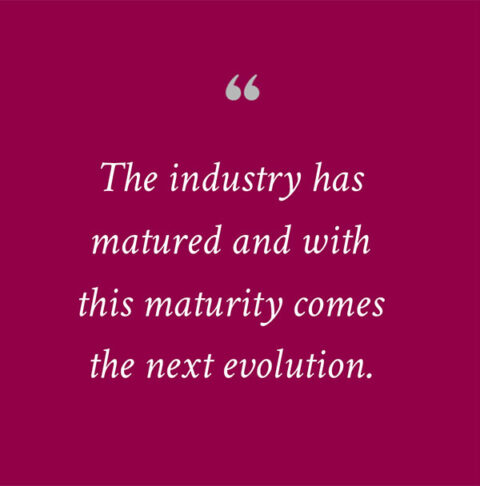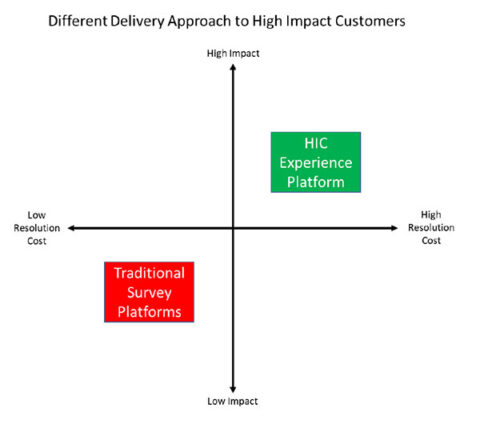Customers are and always have been different and segmented. Do airlines treat their 100,000-mile fliers the same as those who fly a couple of times per year? Do pharmaceutical companies treat their patients who have a rare disease the same as those who have high cholesterol? Should Walmart treat their millions of customers the same way Boeing does with their 5,000 clients? The answer is obviously a resounding NO!
Yet when it comes to helping companies manage the experiences of their customers, the CX industry has a one size fits all approach. There is no special approach or methodology to help companies create exceptional experiences for the customers they simply can’t afford to lose. While in its infancy, the CX industry needed to develop tools and approaches to raise awareness and commitment, so one size fits all may have been the right approach. But this is no longer the case.

The industry has matured and with this maturity, comes the next evolution: a differentiated experience to different customers. We call these customers HIC (high impact customers). Instead, the current trends of relegating services resolution to AI are rampant and it is placing at risk the service level required to retain HIC. High impact customers will refuse to be treated by the current mass market approach as they will see it as dumbing down their issues and as such, inadequate to provide the timely, personalized resolution they seek.

HIC — A Definition
High impact customers are customers with experience expectations that include at least one component of uniqueness and risk and therefore places them at a different category than the rest of the market. These are customers that companies simply cannot afford to lose. Here are some examples:
Pharmaceutical customers – patients with rare diseases where therapy can cost $250,000 per year
B2B – customers with a high long-term transaction value in which churn is a costly endeavor Includes:
* Technology – customers are loyal and have high customer lifetime value e.g., a $95 monthly customer will not be treated the same way as a $5 Million annual service contract customer
* Financial Services – customers with high net worth of $10 Million will not be treated the same way as $2,000 checking account customers
* Manufacturing – products with high purchase price
* Communication Services – HIC count on these services to run the business
Hospitality – club and suites guests with higher demands
Gold and platinum loyalty customers – customers with accumulate disproportionate spend at the company expect a segmented service level
Luxury consumers – buyers of high-end merchandise will expect highly personalized service
HIC are found in all industries and can be segmented in different ways. Think about overall customer lifetime value, customers with high acquisition cost, and your brand ambassadors. These are all HIC in their own way and should be treated as such. In some industries (i.e., specialty pharma, B2B), every customer is a HIC. But even in large B2C companies, there is a natural split of the 80-20 rule; in which the 20% customers create 80% of the revenues. While the service to the 80% is on the road to further automation via an AI, the service to the top 20% HIC needs to be elevated to a new height and requires a different approach and platform.
Customer experience for High Impact Customers – Amplifying the high touch service
High impact customers hate to be automated! Such moves represent to them a degradation in quality of service and therefore an erosion of value. This can often lead to them question the price they are paying and their overall loyalty. In response they will seek to obtain deeper discounts or split their budget with other vendors, when possible. They do not want to feel taken advantage of, additionally, treating them like the masses cannot be more wrong. They want to highlight in small different ways that they are special and receive a distinguished service. AI and the like only further force them into commoditization of the relationship. A recipe to departure and disloyalty.

Welcome to CX for HIC – A service designed from the beginning to delight the most demanding
Demanding, distinguished, dedicated, delivered—these are the four pillars of customer experience for HIC.
Demanding – Recognize the unique nature of these customers and what qualify them as high impact. Is it the time sensitivity or is it the high risk associated with the desired customer experience? Or maybe it is the high volume of business they do with you? Or the mission critical nature of your service in their overall solution. Ross Aviation is a Fixed Base Operator (FBO) which handles private aviation and services. Their clients, owners and pilots of private jets, are extremely demanding in terms of turnaround time and their overall expectations of services delivered. They are quite different from your average airline passenger on Southwest Airlines.
Distinguished – What is the way to engage with your customer experience to make it distinguished? Is there an elevated set of expectations? What makes the nature of experience distinguished and therefore deserving greater attention? In the example above, people who can afford to own private aircraft are in rare air and a distinguished experience is paramount. Their expectations are that the experience will feel different than arriving on the commercial tarmac at LaGuardia. It will be a curated experience that is high-end, from the runway and tarmac to the waiting lounge to the beverages and food served.
Dedicated – Dedicated is all about providing HIC the team of employees with the knowledge, motivation, empathy and empowerment to deliver to the elevated expectations of HIC. Hint—HICs do not like to hunt for a phone number to reach out or navigate an IVR maze to get to the right person. Certainly, Ross Aviation’s clients do not. When the pilot calls to notify Ross when they will be landing, the expectation is that the ground crew will be there well ahead of time, making the last phase of the flight seamless. Once on the ground, these customers expect to be referred to by name, often with a car waiting to take them to their destination.
Delivered – Speed and personalization of the experience will ultimately determine the quality of the experience for HIC. Ross’s customers expect everything to be personalized, from knowing the names of the entire flight party, to knowing their aircraft intimately so it will be ready to take off for their next flight, to where the best place in town is for sushi. Anything less and alternatives will be considered.
Different platforms to delight HIC
Treating HIC across the customer journey ought to be distinctly different. In the same way that a regular room at a five-star hotel will not be receiving treatment equal to the treatment delivered to the Presidential Suite guest, so is the case with HIC. In the hotel case, the general manager will ensure his satisfaction personally and a frequency of checking in will be high with a direct phone number to all requests, so is the case with HIC. Placing them on a mass market designed for service automation, which minimize personalization and humanization, is the exact opposite of their expectations—they expect to be treated differently.

Companies must recognize that HIC need to be serviced and delivered to on a distinctly different platform and approach that respect the impact and value that those customers provide.
Qualifying Questions for HIC
- What percentage of the business does the customer’s purchase value represent?
- What is therisk associated with failing to deliver?
- What is the frequency in which the customer purchases?
- What is the loyalty level of the customers?
- What level of expectations are associated with the purchase?
These questions may guide the definition of the customer segment that will be your HIC and therefore should be delivered to with a differentiated service.
In conclusion
HIC are different by design. Treating them with the same approach and on the same platform as the mass customer-base includes several risks:
- A mismatch between their expectations and the delivery quality which will result in greater dissatisfaction
- Failure to recognize their special needs
- Failure to respond to their tight timeframe
- Failure to recognize their volume issues
- Disrespecting them by including them and sometimes deprioritizing them with other lesser impact customers
Customers have never come in a one-size, one-color fits all model. It was always easy for companies to treat them that way in the name of cost management. Yet, those savings are coming at the expense of a growing empowered customer who is seeking a shift from the one size fits all approach to the “meet me where I am” approach. We cannot stuff them all into economy class and expect them to be happy. The airlines recognized that they ought to segment and differentiate their value to cater to the different approaches and HIC. It is time for the rest of the CX industry to catch up to what is seemingly the most obvious tenet of its strategy.